Encounters with wildlife aren’t always experiences that are memorable for good reasons, and this abandoned Coot chick is a perfect example of when wildlife photography can tug at the heart strings of animal lovers everywhere. Some of you may remember me tweeting that I had found an abandoned coot chick whilst out shooting a few weeks. So, although a slight change from my normal trip write ups, here is the little things plight documented as I watched it wonder around the lakes edge.
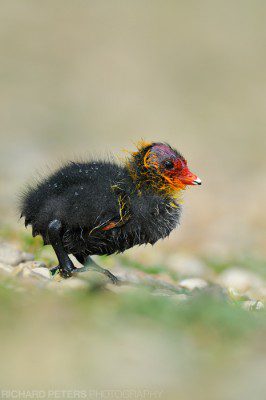
D3s, 600 VR + 1.4x, 1/1000, f8, ISO 640
I hadn’t actually spotted this tiny little chick at first. I was laying by the side of a lake with fellow photographer Jai Grieve, waiting for the local Great Crested Grebes to come past. In the distance was a family of Coots, with the adults tearing apart a fish they had caught to feed to the eager young that were swimming around them. We fired off a couple of record shots as it was quite far off, then got back to watching the Grebes. Maybe 10 minutes later, I noticed the Coot family making their way across to my side of the lake. Watching them through my camera, I trained my lens on one particular young Coot and then as I followed it around I noticed it swim over to the edge of the bank and look at something. I wondered what the furry little object was that had caught the youngsters eye, until I saw it move. I then realised it was a very, very, little coot chick. Seeing the two chicks side by side gives you an idea of just how tiny the smaller one was.
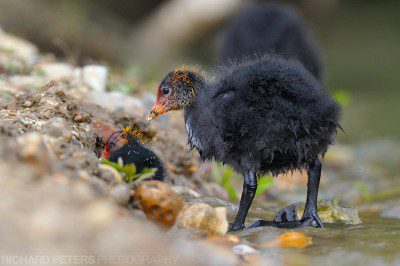
The two Coot chicks, for size comparison
Before long the curious youngster swam off and the adult came over. At first I thought maybe this had been one that was left behind earlier and they’d come back for it, and then when the adult appeared to be trying to feed the tiny chick I was sure that was the case, although the interaction didn’t really feel particularly nurturing. My shooting buddy Jai, suggested the ‘runt of the litter’ was more than likely being attacked, and upon further observation it was clear the adult was trying to bite the head of the youngster and not feed it at all. After a minute or so, the adult swam off before coming back for another couple of bites, before finally swimming back across the lake and taking the rest of the family with it. The abandoned chick was so much smaller than the other chicks I’m not sure if it was from that family or another, as there are a few on the lake with young of various sizes, maybe that is why it wasn’t accepted by the adult (if anyone knows coot behaviour very well and knows what the most likely scenario is, a) lost or b) abandoned it’d be great to know).
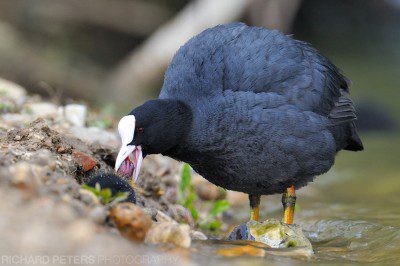
Adult Coot biting the chicks head
Once the family had gone I took a closer look at the chick. I was amazed I had missed it before as we had walked past where it was hunkered down, and we’d been at the waters edge nearby for some time. But there it was, tiny, fragile and it looked to be shaking. The water was very cold and it was quite windy, so adding that to having just had an adult bite it’s head I’m sure it was less than happy.
I went back to my position to watch the Grebes but kept an eye on the chick as well, and after another 20 minutes or so it got up and started making it’s way along the waters edge towards me. Being so small, it was getting knocked about by the waves as they lapped against the shore but it pushed on, before eventually finding a spot where it could get up on to dry land.
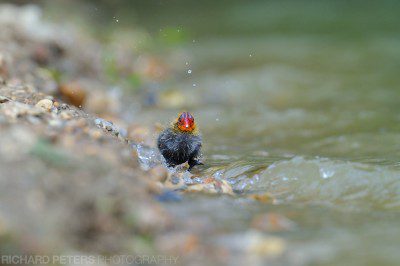
Tiny Coot chick battles the waves
Once there it wondered along, heading straight for me but seemingly unaware I was there as it looked to be more interested in trying to taste the various plants and weeds dotted around. I expect it was quite hungry if it had been left to fend for itself. Seeing it huddled against some small plants and greenery growing out the ground I could really appreciate just how small this chick was. It spent some time wondering around the bank, walking up to the steep ‘hill’ nearby before realising it couldn’t climb up, then wondering back away from me. It gained the attention of several ducks and geese that were swimming past, and when a larger bird would come along it would just freeze and not move until they swam off.
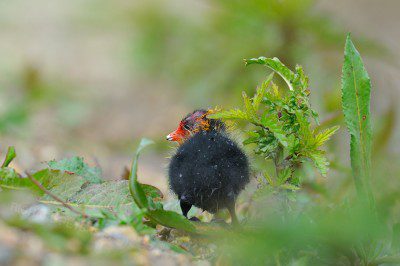
Huddled up looking for food
It eventually settled away from the waters edge and in a sheltered spot from the wind. It sat for so long that I started to let my attention sway a little more towards the grebes I had originally been there to see and it was then, when I wasn’t looking, that it made its move up a section of bank that wasn’t as steep. I caught it out the corner of my eye and quickly stood up to see it go up over the grass at quite a quick pace, across the pathway and in to the tall grass and hedgerow down the other side. Once it was gone from sight in the undergrowth I never saw it again, so I have no idea what was to become of the poor little chick as beyond the hedge was fields, very tall grass and more crucially, no water.
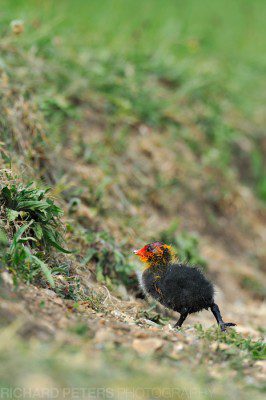
Banks are too steep for the Coot chick
I have to admit, I felt extremely sorry for the poor little thing, and a huge part of me just wanted to do something to help but I knew wondering around the lake seeing if it belonged to any of the other coots, or driving it 50 miles home to hand rear was a little unrealistic. This is the reality of the wild unfortunately, it’s survival of the fittest, even when you really wish it wasn’t.








